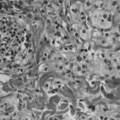Difference between revisions of "Histiocytoses"
Jump to navigation
Jump to search
| Line 48: | Line 48: | ||
*''EM'' = [[electron microscopy]]. | *''EM'' = [[electron microscopy]]. | ||
The classification has evolved considerably, as the entities can overlap. | The classification has evolved considerably, as the entities can overlap. An overview of a more recent classification is found in the article ''[[classification of histiocytoses and neoplasms of the macrophage-dendritic cell lineages]]''. | ||
==Langerhans cell histiocytosis== | ==Langerhans cell histiocytosis== | ||
Latest revision as of 18:55, 23 July 2019
Histiocytoses, singular histiocytosis, are a rare set of conditions affecting tissue macrophages.
Historical classification of histiocytoses in a table
Features of histiocytoses:[1]
| Histologic features | EM features | CD68 | S-100 | CD1a | Image | |
|---|---|---|---|---|---|---|
| Macrophage | epithelioid cells, giant cells | - | + | - | - | Macrophages - CD68 (WC) |
| Erdheim-Chester disease | Touton giant cells | - | + | +/- | - | ECD (upmc.edu) |
| Rosai-Dorfman | Emperipolesis | - | + | + | - | RDD (WC) |
| Langerhans cell histiocytosis (LCH) | Reniform nuclei, eosinophilic cytoplasm |
Birbeck granules | + | + | + | LCH (WC) |
Notes:
- EM = electron microscopy.
The classification has evolved considerably, as the entities can overlap. An overview of a more recent classification is found in the article classification of histiocytoses and neoplasms of the macrophage-dendritic cell lineages.
Langerhans cell histiocytosis
Main article: Langerhans cell histiocytosis
IHC
Langerin (CD207).[2]
Erdheim-Chester disease
- Abbreviated ECD.
General
- Rare.
- Clonal proliferation of histiocytes; 3 of 5 cases shown monoclonal by Chetritt el al.[3]
Gross
Features:
- Bone involvement - classic.
- Usually multiple systems are involved.
Note:
- Does not usually involve the lymph nodes - like Rosai-Dorfman disease.
Microscopic
Features:[4]
- Foamy histocytes.
- Large cells with gray, bubbly cytoplasm.
- +/-Touton giant cells - very distinctive histiocytes - classic.
- Nuclei form a ring around the cell periphery.
DDx:
Images
www:
IHC
Features:[5]
- CD68 +ve.
- S100 -ve/+ve.
- CD1a -ve.
See also
References
- ↑ Mills, Stacey E; Carter, Darryl; Greenson, Joel K; Oberman, Harold A; Reuter, Victor E (2004). Sternberg's Diagnostic Surgical Pathology (4th ed.). Lippincott Williams & Wilkins. pp. 479. ISBN 978-0781740517.
- ↑ Online 'Mendelian Inheritance in Man' (OMIM) 604862
- ↑ Chetritt, J.; Paradis, V.; Dargere, D.; Adle-Biassette, H.; Maurage, CA.; Mussini, JM.; Vital, A.; Wechsler, J. et al. (Sep 1999). "Chester-Erdheim disease: a neoplastic disorder.". Hum Pathol 30 (9): 1093-6. doi:10.1016/s0046-8177(99)90228-9. PMID 10492045.
- ↑ Sheu, SY.; Wenzel, RR.; Kersting, C.; Merten, R.; Otterbach, F.; Schmid, KW. (Nov 2004). "Erdheim-Chester disease: case report with multisystemic manifestations including testes, thyroid, and lymph nodes, and a review of literature.". J Clin Pathol 57 (11): 1225-8. doi:10.1136/jcp.2004.018481. PMID 15509691.
- ↑ Haroche, J.; Amoura, Z.; Touraine, P.; Seilhean, D.; Graef, C.; Birmelé, B.; Wechsler, B.; Cluzel, P. et al. (Jun 2007). "Bilateral adrenal infiltration in Erdheim-Chester disease. Report of seven cases and literature review.". J Clin Endocrinol Metab 92 (6): 2007-12. doi:10.1210/jc.2006-2018. PMID 17405844.
